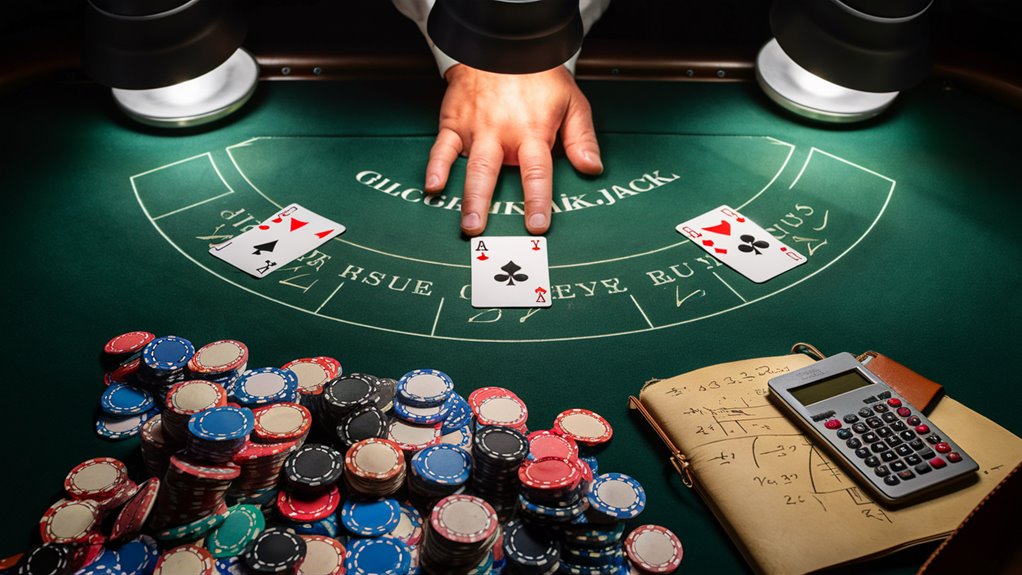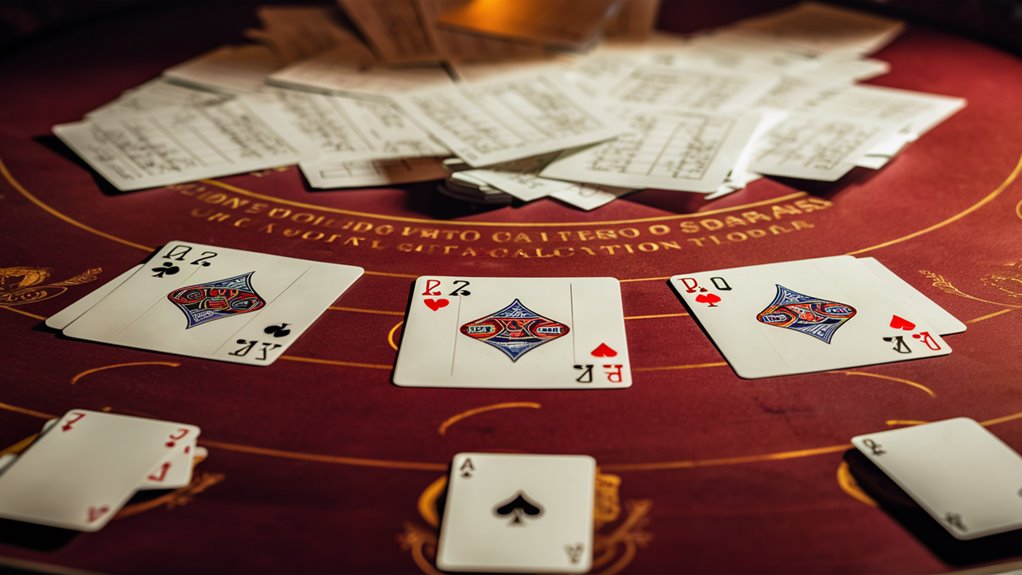
Win with Math in Blackjack: Smart Moves

Know Basic Math in Blackjack
Math in the game is key for the best play, showing clear ways that smart players use. Good play calls come from deep number study – when you have a hard 16 and the dealer has a 7, you face a 69% risk of losing if you hit and a 77% if you stand. These set numbers show the best move in each spot.
The Edge of the House and How to Beat It
The house has the lead as it makes you go first, making you decide without seeing the dealer’s hand. Yet, using smart, full play drops this edge to about 0.5%. This math base gives chances to players who know these odds. 추천 업체 리스트 확인
Deep Math: How Card Counting Changes the Odds
Counting cards can change the edge. Every big card gone from the game shifts the edge by 0.5-0.7%, showing how what cards are left can change how likely you are to win. These number shifts give sharp players an added edge when they track and use them right. Mixing these math bases shows the real deep game of blackjack, where every choice is a weighed risk versus gain, all set by good math.
The Math Behind Smart Play
Why the Right Moves Count
Base Your Moves on Math
Smart blackjack play fully rests on math that shows what to do with each hand you get. This math is the core of good play, letting players make sound choices when it matters.
Main Math Ways
A key case is having a hard 16 with a dealer’s 7. Math tells you there’s a 69% chance of busting if you hit, against a 77% chance of losing if you stand. While both look bad, hitting is shown by the numbers to be a bit better.
Deep Math Thoughts
Changes from card pulls add more math depth to strategy. Seeing certain cards play changes what’s left to draw, making small shifts in the odds. When more low cards have been seen, the stack gets rich in big cards, helping you with choices like splitting pairs or doubling down. These number twists play into every decision in the game.
Main Math Bits:
- Chances to make your hand better
- What the dealer might end up with
- What cards are left in play
- What you might gain or lose with each play
- Chances of winning
Seeing these complex number ties turns basic strategy from just rules to a smart, number-based plan for top blackjack play.
Break Down How Card Counting Fits In
The Math of Card Counting: Number Breakdown
Get How Numbers Spread in Counting
The core of counting cards math is a key stats idea: taking cards out changes number spread. This number base lays out smart card play.
How Big and Small Cards Shift the Odds
When big cards (10s and faces) drop out, you lose about 0.5% to 0.7% edge per card. On the flip side, losing small cards (2-6) boosts your edge by about the same. The true count score, found by dividing the running count by decks left, marks these shifts.
Count and Use the Numbers
In a new six-deck, the chance of getting a ten-value starts at 30.8%. After 20 ten-value cards play, this chance tweaks to 29.6%. This small change boosts how well you can bet and play. With a true count of +3, the house’s lead flips to a player lead of 1%, pushing you to bet based on these precise counts.
How the House Keeps Its Edge
Get How the House Stays Ahead

Base Math for House Lead
The house lead number is a must-get in deep blackjack number study, showing the edge houses have over players. The main dealer’s plus comes as players must go first, risking a bust before the dealer plays.
Deep Odds Work
In-depth number work sets up house edge counts, looking at all ways players and dealers can start. This check covers all first two-card mixes and what might follow. Under common Vegas ways, deep math shows a house edge of 0.5% to 0.6%.
How Rules Change the Edge
Rule tweaks greatly shape the house plus:
- Dealer hits on soft 17 raises house lead by about 0.2%
- Double down after splits drops house edge by near 0.14%
- Smart, full play gets you to the smallest edge possible
- Table-specific ways make the edge vary place to place
Using smart full play with these counts shows the least house edge you can get, but you must make every move right.
The Odds of Going Over 21
Get the Odds of a Bust in Blackjack
The Math That Shows When You Might Bust
Bust odds checking is a key math part in blackjack play. It looks at how likely you are to go over 21 if you hit, based on what you have now. High starts mean high risks of going bust.
Main Bust Odds
Key odds notes show the risk growing as your hand does:
- Hard 12: 31% bust risk
- Hard 16: 62% bust risk
- Hard 17: 69% bust risk
- Hard 20: 85% bust risk
Smart Moves to Make
The tie between risk and smart play often goes against what you might think. With a dealer’s 10 and a hard 16, smart play says hit even with a big 62% bust risk. This choice is based on number work that shows standing is even more likely to lose.
Thinking Ahead on Odds
Top blackjack needs you to balance many odds:
- What you now hold
- What the dealer shows
- What cards are left to play
- Chances of winning if you stand
These bits form the core of top game play, where you must think over bust odds versus how likely it is the dealer wins if you stand still.
When to Double Your Bet
When Doubling Down Works Best
Get the Base of Doubling Down
Doubling down calls in blackjack need deep looks at many bits that set win chances. The math heart of smart doubling looks at your cards against what the dealer shows.
Clear Chances to Double
Hard counts give clear times to double. With a hard 11, double against any dealer card but an ace, using the 31% chance of getting a ten. With a hard 10, double on dealer cards 2 through 9 for better odds. A hard 9 says double only on dealer’s 3 through 6.
Soft Hand Doubling Game Plan
Soft hand plays open doubling chances. Ace-6 says double on dealer’s 3 through 6, and Ace-7 hands say double on dealer’s 2 through 6. Don’t double on soft totals over Ace-8, as these hands are already strong. The main point stays: smart doubling balances possible wins against the risk of your bigger bet.
Odds Edge in Doubling Choices
Winning on doubles relies on seeing number edges over the dealer. Each call must weigh odds against how much more you stand to lose. Deep number checks show that right doubling can greatly lift your overall game wins when done right.
Smart Pair Splitting
Splitting Pairs: Math that Wins
How to Think on Splitting Pairs
The smart edge in splitting pairs in blackjack stems from precise number checks that guide top play. Splitting makes two hands, each with its own chance setup. This smart move leans on both the pair’s card values and the dealer’s shown card, building smart play.
Must-Split Times
Aces and 8s are times you have to split, by the numbers. Split Aces make two big chances for a blackjack or strong hands. In the same way, paired 8s turning a weak 16 into two chances for better hands via splitting. Online Gambling Addiction
When Splitting Fails
Number checks show that splitting 5s and 10s drops your chance to win. Paired 5s set up a solid 10, while paired 10s make a great hand of 20. Numbers back up keeping these pairs as one over splitting.
Choosing When to Split
Splitting 2s, 3s, and 7s truly depends on the dealer’s card shows. Number models point to smart splits when the dealer shows 2 through 7, as these spots give a number edge to the player. This thought out method aims to lift wins over many hand mixes.


